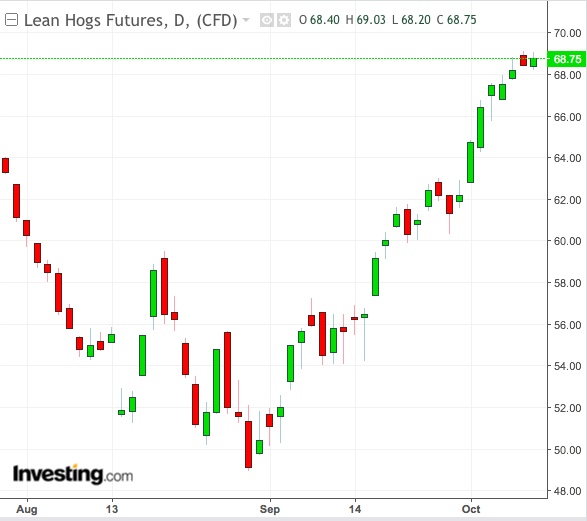“When pigs fly” is one of those perfect idioms to describe the impossible. It’s probably what some livestock traders would have thought had they heard this past summer that US hog prices would take off in a super rally and continue soaring almost every day—when, at that time, the market was falling almost daily.

Indeed, Lean Hogs Futures on the Chicago Mercantile Exchange have been on a tear the past six weeks, gaining 35 percent in September and nearly 11 percent since the start of this month.
CME live cattle futures have been in rally mode too, though their gains have been more modest, with a 7 percent rise in September and a flat return so far in October.
While traders who’ve been on the right side of the two markets are celebrating, some analysts are questioning the fundamentals behind the gains, and whether they’re solid enough to prevent a sudden price collapse.
Hard To Read Demand
“To me, the demand for meat is very, very hard to read,” said Don Roose, who’s followed futures of hogs, cattle and an assortment of agricultural markets for more than 30 years at his West Des Moines, Iowa brokering firm, US Commodities. He adds:
“It’s more the supply that we know. While the U.S. export pace has been slow the past two months, we know we’re going to have record supplies of hogs for the rest of the fourth quarter. Those supplies are going to remain at record highs in 2019, some 4.5% over 2018. You can add to that, record supplies of beef too. To me, all these means you’re going to have to have demand that’s very strong. Will that happen? No one knows for sure.”
At Tuesday’s settlement, the front-month contract for CME lean hogs for December delivery, settled at $56.57 per hundredweights. Investing.com’s daily technical outlook has a “Strong Sell” on the contract, with Fibonacci patterns calling for resistance from $68.93 onward.
But live cattle earned a “Strong Buy” rating, with no immediate sell targets in line for its front-month December contract, which last traded at $117.40 per hundredweights.
Just in mid-August, hog prices were down 25 percent on the year, the third worst performer among 60 global commodity and currency futures. The cattle market was also significantly lower, by around 11 percent.
China And The Swine Fever
Since then, the rebound can be credited to two things: China and the Asian Swine Fever.
An epidemic has been spreading to pigs across borders since 2014, which reached Western Europe last week, and saw China report the first hog fatality from the fever—referred to by its cryptic shorthand ASF— on August 3. There have been 29 outbreaks since, forcing authorities to cull nearly 40,000 pigs.
On the surface, the waste of less than 50,000 pigs may barely seem a threat to the world’s top pork producing and consuming country, which puts out nearly 55 million metric tonnes of the meat a year, all for domestic consumption, and buys another 1.5 million tonnes from mostly Germany.
But more than the actual culling that has taken place so far, the psychological impact of ASF on China has been greater. And that fear has reverberated across global meat markets, where enormous profits have been estimated for other countries and their farmers that may be called up to supplement Chinese demand, should the virus turn pandemic in the country.
“We feel that by year end the jury will be out on which pathway this ASF situation will take in China,” said Shawn Hackett of Hackett Financial Advisors, an agricultural markets’ research firm in Boca Raton, Florida.
Can China Crisis Be A Boon To The US?
Hackett added:
“A 10 percent reduction in Chinese pork production from ASF-related culling or just pig deaths would mean a loss of 5.46 million metric tonnes. The Chinese would consume or import two times more pork than would be available from the export market to fill the supply gap. It just can’t be done.”
Speculation has swirled in recent months that the United States, which comes in as the world’s third largest pork producer with more than 11 million metric tonnes after Europe’s 23 million, would stand to benefit if the Chinese crisis worsens.
That explains the rally in CME hogs, which has pulled along the cattle market for company, though China’s imports of US beef are negligible.
But there’s a problem with those bets on China: Its trade war with the US is costing the American meat industry dearly, with Beijing imposing a 62 percent tariff on pork, and duties of up to 50 percent on beef products from the United States.
That’s what’s puzzling analysts like Roose. He reckons that unless the two nations make their peace on trade soon, the lofty livestock prices seen on the CME may be hard to defend.
“The theory goes that China is going to buy pork from the rest of the world and the rest of the world will buy pork from the US, just like the workaround we have for soybeans, which are also under China tariffs. Will that be the case? I don’t know, but there’s a possibility.”
